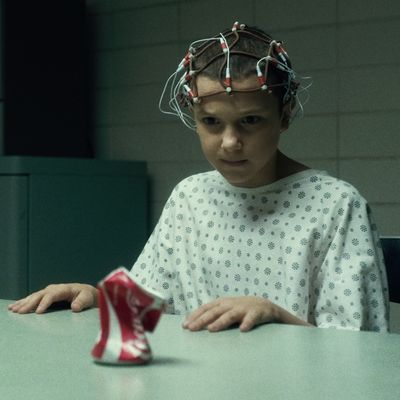
Released amid a wave of cheapo slasher films that flooded theaters after John Carpenter’s Halloween, Wes Craven’s 1984 horror classic, A Nightmare on Elm Street, stood out for submerging the slice-and-dice subgenre in a vivid dreamscape. With Freddy Krueger, its razor-gloved killer seeking revenge from beyond the grave, the film toys with an irresistible idea: Nightmares are not just contained in sleep, but capable of invading the real world. By falling asleep, its characters open up a portal through which a serial killer can attack them at their most vulnerable state. Yet they must sleep, as all humans do, so they try to develop survival strategies, like having someone in the waking world ready to pull them back into consciousness.
It’s hard not to think of A Nightmare on Elm Street when watching Elle climb into a makeshift sensory deprivation tank in “The Bathtub,” the breathless penultimate episode of Stranger Things. (It’s hard also not to think of the precogs in Steven Spielberg’s Minority Report, but that’s another story.) The issue with Elle, as it is with the teenagers in Craven’s film, is trust. She’s about to enter a terrifying place, one that seems to neutralize her telekinetic powers, and she needs someone to pull her out of it when she gets in trouble. We know from flashbacks that Dr. Brenner was not that man. He pushed her to go further into what she calls “the Upside Down,” under the false assurance that she could make contact with the faceless creature without harming herself. In the process, Elle opened “the gate” in Hawkins. Now everyone’s struggling to contain the threat.
Joyce has an even stronger motivation to push Elle than Brenner did. She’s still looking for her son, after all, and it’s not an easy choice to value Elle’s safety when the mission to find Will is of utmost importance to her. But Stranger Things has followed Elle through a touching progression — first with Mike and his friends, now with Joyce and the others — where she’s come to understand that people can care about her without pulling the strings. She clung to Brenner like the “papa” he’s pretended to be for her; she’s easy to exploit because she doesn’t know what real parental love feels like. She’s never known the world outside the lab-rat limits of Brenner’s experiment. Accepting genuine kindnesses has been difficult for Elle to do, and her reluctance extends to the very beginning of this episode, when Mike cleans her face like the orphaned Newt in Aliens. Elle hasn’t known Joyce for long before she volunteers to plumb the Upside Down for her, but Winona Ryder and Millie Bobby Brown make their immediate bond persuasive. Though Joyce doesn’t know Elle, her assurances are as close to real parental affection as the girl has experienced.
In the lead-up to the season finale, “The Bathtub” also offers the satisfying union of characters — Mike and the gang, Hopper and Joyce, Nancy and Jonathan — who have operated independently until now. (“From now on, we tell each other everything,” Nancy says to her brother, immediately before they both lie about their true feelings for Jonathan and Elle, respectively.) There are no questions left to answer, no secrets left to keep. It’s just one group of Hawkins citizens looking to rescue two of their own, and one group of government goons looking to stop them. Building the sensory deprivation tub is a satisfying team project — and a clarifying one, in that Barb appears to be dead and Will appears to be clinging to life — but our heroes still have separate ideas about how best to move forward. Hopper and Joyce impulsively set out to rescue Will; Nancy and Jonathan still want to follow through on their plan to trap the creature.
As all these elements coalesce for the final hour, the grand design of Stranger Things is taking shape. There are difficulties inherent in reviewing a series like this one piecemeal, because it’s hard — and sometimes flat unfair — to make conclusions about a show that might be premature. You can only react in the moment and have your suspicions about what it might mean in the end. The Night Manager, which I recently recapped, was a cautionary example for me: I enjoyed the superficial pleasures of the plotting and performances, but my worries about the significance and depth of its politics couldn’t be confirmed until the finale, which I panned. That’s not to say Stranger Things is headed in a similar direction. For now, it’s looking like a fun, surface-level pastiche of influences that occasionally cut a little deeper.
Not that there’s anything wrong with that. The Duffer brothers have immersed us in a warm, pleasing bath of ‘80s nostalgia and it’s been fun to float around in it, soaking in memories of Spielberg, Carpenter, Stephen King, and new-wave radio. There doesn’t appear to be a portal for wresting Stranger Things from the past to present-day relevance, but then, there’s something to be said for nostalgia for its own sake, especially when it’s evoked with this much skill and feeling. We’ll soon see if it sticks the landing.
Demogorgons:
- The references to Carpenter’s The Thing have me hankering for the gross, old-school special effects that make that film great, but in the meantime, the CGI of the van flipping over will have to do. Modine’s reaction shot is nearly as satisfying as the effect — he’s not surprised by it in the least.
- Steve’s reemergence as a redeemable jerk brings him back in the fold for the finale, suggesting a late-breaking love triangle between him, Jonathan, and Nancy. At this point, though, any narrative business that isn’t monster-related holds little interest.
- “We have to trust them. This is our government. They’re on our side.” Even though a fleet of agents raid his house and make ominous threats about his son’s safety, Mike and Nancy’s dad still has faith in the feds.
- Dustin’s reason for building a sensory-deprivation tank at 10 p.m on a Saturday night: “… fun?” It’s as good as any!


